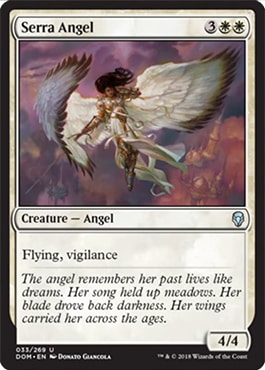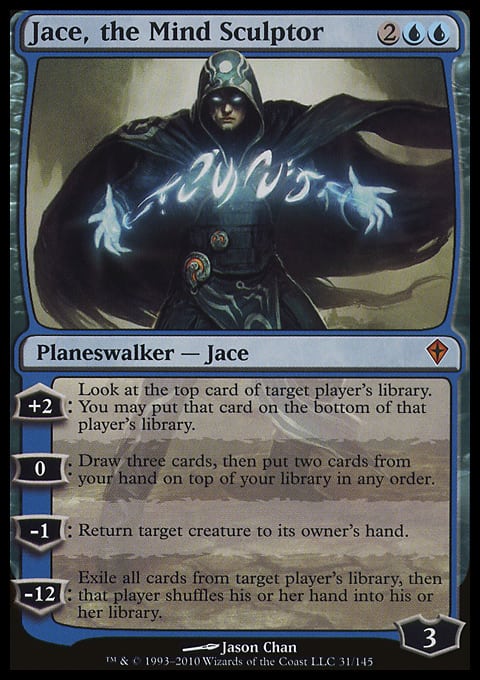Naturally, the point of any business is to generate income. Business is all about the bottom line. That being said, consumer-friendly business practices usually make the most sense in the long term. Retaining your customers and keeping them happy are the keys to sustaining long-term success in the business world—which is why some of the choices made by the people running the show at Wizards seem a little bit shortsighted.
Wizard’s profit-generating engine started with the invention of Magic—and in the process, the invention of the trading card game. Before Magic, typical games were pretty much one-shot deals. You bought your copy of Monopoly or Uno, and you were done investing money in that particular product after a one-time payment of $10 to $30. That business model was improved upon by various hobby games such as Dungeons & Dragons (it’s probably not a coincidence that Wizards now owns D&D). After you purchased the books or box set needed to start playing D&D, there were more books (modules) you could buy to enhance your game. Of course, now that Wizards owns D&D, every couple years, the game is revised, and you have to buy all of the books all over again to be playing the “official” version.
While role-playing games helped you to make more money per customer by allowing you to gradually expand your product line and make more products for the same game, they barely hinted at the kind of profit per customer that could be generated by a TCG. Richard Garfield’s invention forever reshaped gaming both from a gameplay perspective and from a business perspective.
Now, if you bought one unit of the game—a starter deck—you were barely capable of playing, and a second one needed to be purchased before two people could play. The TCG model directly tapped into a player’s desire to win. If you didn’t care about winning, sure, you could just buy a starter deck, but you needed to be prepared for massive mana issues and losing every game to Joe Suitcase’s carefully constructed deck made from the equivalent of twenty (or more) starter decks. Unlike “normal” games, winning wasn’t merely about playing well; the more units of the game you bought, whether decks or packs, the better your deck could be, and the better your chances of crushing your friends. Thus, the more money you spent, the more likely you were to win. Now not only was there no limit to how much money you could spend on a specific game, but you were strongly motivated to spend every available dollar on the same game. It wasn’t merely that a pack of cards had random contents—Wizards had made cards of different rarities. By making some of the more powerful cards artificially rare, serious players were forced to buy even more packs and spend even more money to acquire the cards they needed.
An additional reason this game was so innovative (and insidiously genius) was that it required every participant to invest. Even with a game like D&D, one person could purchase all of the books and then gather a large group of other people to play it with who didn’t own the game. Magic is designed to encourage every single participant to own his or her own cards and build his or her own decks.
Just when ambitious collectors and players had spent enough money to acquire multiple copies of every available card, they would print whole new sets of cards for the game, and the scramble to give Wizards money would begin all over again. Of course, players could choose not to buy new sets and just play with the large collections they already had. After a few years, Wizards “solved” this “problem,” too, with the invention of Type 2, now better known as Standard. By always making the current official Magic format require the most recent sets, players who wanted to play in tournaments—or even just have a lot of opponents—needed to keep buying packs.
As the first, best, and most popular TCG, Wizards can, did, and continues to reap great financial gains from this one single game and this innovative business model. At this point, TCGs are an excepted part of the gaming landscape, and gamers understand that by choosing to become involved with one, they will have to make a significant financial commitment. Yet, Wizards hasn’t been content to enjoy the status quo. Just as they keep innovating game design and organized play, they also continue to innovate the game’s business model and how to bring us to give them even more of our money for the same game.
The next big innovation was making an online version of the game. Why not take the exact same business model that was making them so much money in the physical world and unleash it digitally? The timing worked out great, too. Magic Online was released before the existence of the iTunes store or the Kindle, and the concept of a digital economy was still in its infancy. When digital games are released now using an economy, they typically use a series of small or even “micro” purchases. After all, a digital image costs a company a tiny fraction of what it costs to make a physical object like a Magic card. Yet, with little precedent to work from, Wizards boldly decided to charge the full price for digital cards, as though they were physical cards. While they did back this up with a redemption program, I’m certain that nine out of ten customers would rather the costs of Magic Online be much lower and to have there not be a redemption program. Yet, with time, the customers came, and now Magic Online is big business, much like the rest of Wizards’s Magic empire.
As other TCGs like Yu-Gi-Oh! grabbed profit by creating greater numbers of rarities and incredibly rare cards that generally required the purchase of epic numbers of packs to acquire, Wizards took notice. In 2008, they introduced a new type of rare: the mythic rare. Previously, every single pack was guaranteed to contain a card from the scarcest rarity. Now seven out of eight packs wouldn’t. Instead of receiving a card from the most valuable category of cards in every single pack, you could now spend all of your extra cash on packs and not receive any. As players and retailers burned through money and boxes of packs chasing mythics, the market became flooded with cards of lesser rarities, making them almost worthless. For me, this evokes memories of managing a game store and selling packs of Yu-Gi-Oh! All too often, a Yu-Gi-Oh! player would come to the counter, buy a pack with his or her last few dollars, open it, and then leave the entire opened pack behind on the counter when he or she realized that the the pack didn’t contain one of the coveted super rares and that every one of the cards in the pack was nearly worthless. Suddenly, it felt as though we were selling lottery tickets—lottery tickets that were targeting kids and young adults.
The sort of profit min-maxing that Wizards uses in their product sales is sometimes reflected in organized play as well. Probably the most glaring example of this is the Grand Prix system. The last ten Limited Grands Prix have averaged close to two thousand players each, with the most recent one, Grand Prix Las Vegas, coming in at four thousand four hundred ninety-two players. The entry fees start at $40 per person, yet first prize for winning one of these events with thousands of people is a mere $3,500. To be fair to Wizards, it’s possible that their prize structure (including Pro Tour invites) is reasonable for the type of attendance they used to receive years ago, but they’ve been regularly breaking a thousand players in their Grand Prix attendance for around four years now, which is plenty of time to have rescaled their structure to reward players for their enthusiastic attendance and encourage it to continue.
The latest example of Wizards’s clever widening of their profit margins is Modern Masters. When a typical Magic set is printed and released, a pack of fifteen cards has an MSRP of $3.99. Yet, when Wizards released Modern Masters, a set of all reprints, requiring no new design or development work on their part, the MSRP was suddenly $6.99, an eye popping seventy-five percent increase over the price for a pack of all new cards that actually requires design and development. By choosing to include a large number of cards with a preexisting high value on the secondary market and only making a short print run, they were able to not only ensure players would be willing to pay the dramatically higher new price, but that retailers could actually jack prices way above the already artificially inflated MSRP and still sell through their product, with prices sometimes reaching as high as $15 a pack while the set was still considered to be “in print.”
In each of the cases I’ve noted above—and usually even in the ones I haven’t mentioned, such as with the introduction of foil cards—Wizards of the Coast has perfectly reasonable-sounding explanations for their choices that don’t just amount to, “We want more of your money, and we want it now.” None of which really matter in the end, of course. If someone is willing to pay you $10 for something you would have been happy selling for $1, why wouldn’t you take the $10? This is especially true now that Wizards of the Coast is owned by Hasbro. Once you involve shareholders, CEOs, a board of directors, and various other interested parties who are far removed from the consumer but who are directly affected by the company’s profits, the immediate bottom line tends to dominate policy-making.
History would suggest that as long as Wizards continues to make a good product, people will keep buying it. I can’t help but wonder, though, if their drive to maximize their immediate profits will prove shortsighted eventually. Perhaps it will open the door for competitors with a more consumer-friendly approach. More importantly, perhaps other parts of life will suddenly start being able to compete with Magic for people’s attention. At what point does going to the movies or having a board game night suddenly become more appealing than going to the local game store to buy some cards and play in a tournament? For all our sakes, I hope the answer is “never,” and I hope that’s because Wizards of the Coast starts putting their customers first more often.





























